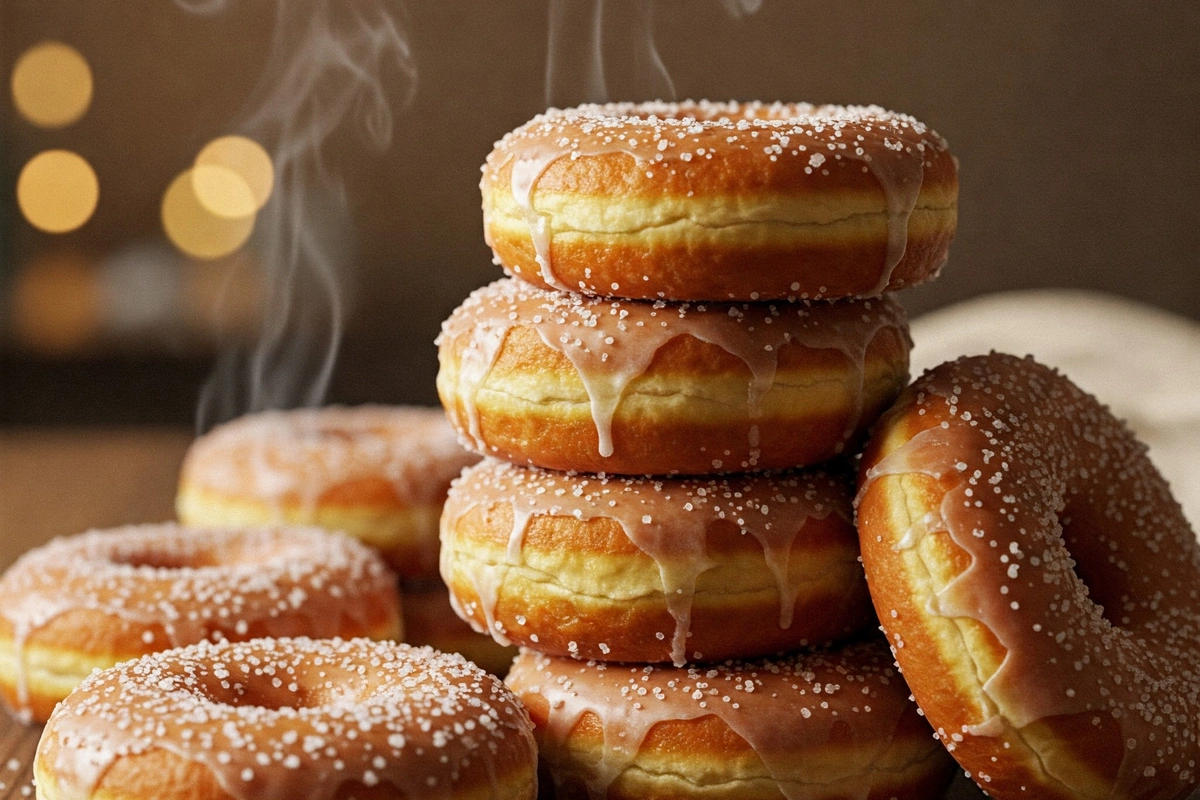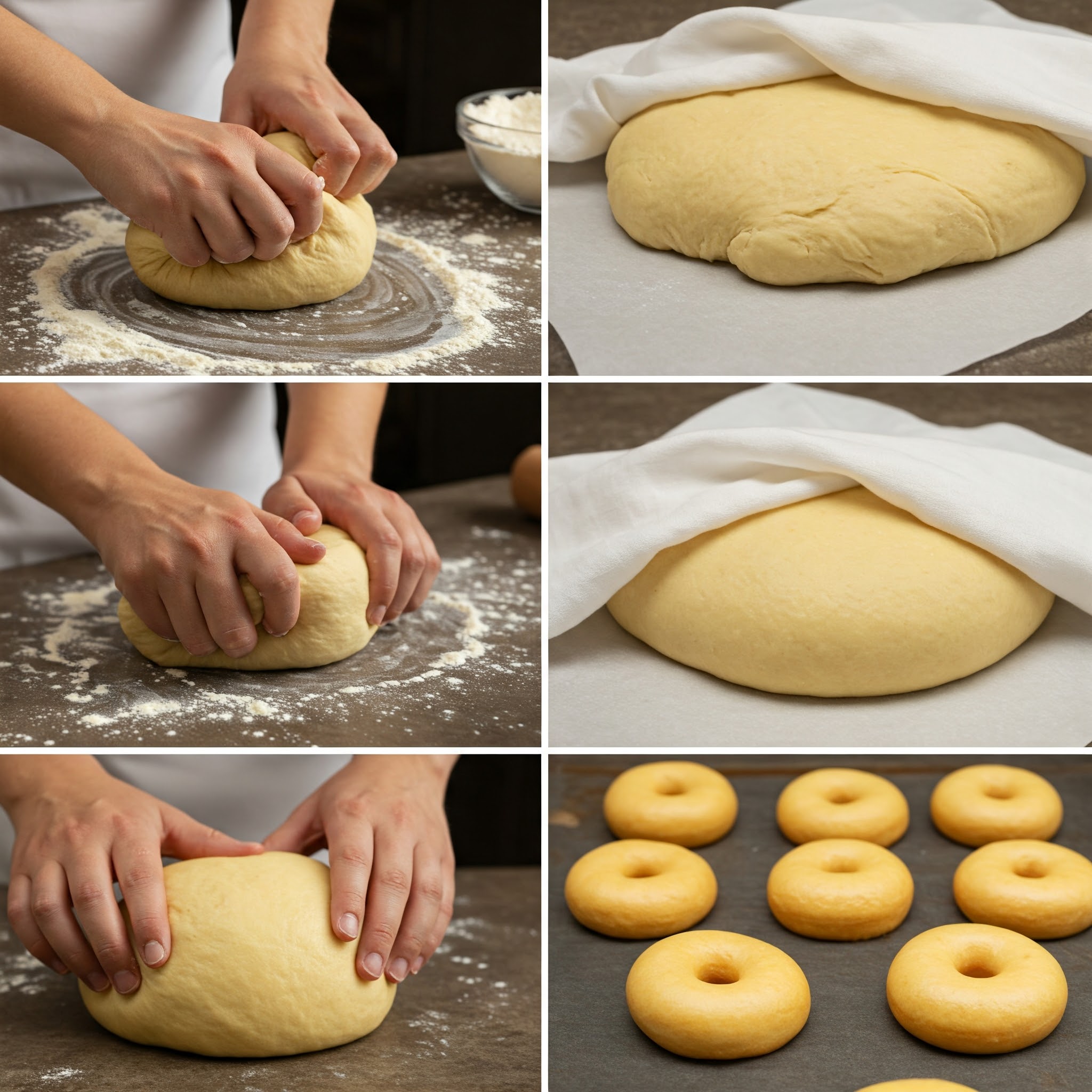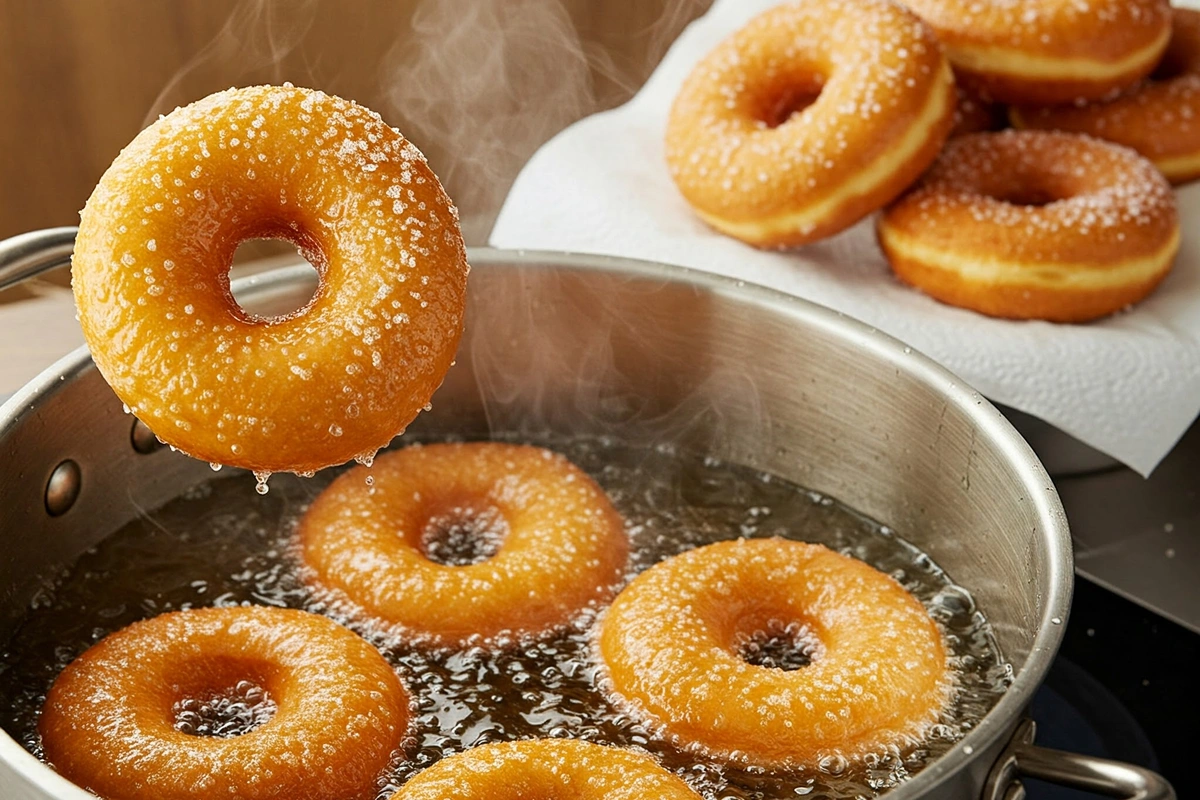Soft, fluffy doughnuts are the stuff of dreams—comforting, tender, and almost melt-in-your-mouth good. Yet, achieving that perfect texture is no easy feat. Many home bakers end up with doughnuts that are dense, oily, or just plain disappointing. So, what is the secret for soft doughnuts? This article breaks it all down, from the essential ingredients and preparation techniques to expert tricks and troubleshooting tips. Whether you’re a seasoned baker or just starting out, you’ll find plenty of valuable insights to ensure your doughnuts turn out perfectly every time.
Now, let’s dive into the details, starting with what makes soft doughnuts so irresistible.
Introduction to Soft Doughnuts
What Defines a Soft Doughnut?
A soft doughnut isn’t just a treat—it’s a texture triumph. These doughnuts have a light, airy interior and a slightly crispy outer layer. When you bite into one, it should feel pillowy and moist without being heavy or greasy. The perfect balance of chewiness and tenderness is what sets soft doughnuts apart from their denser counterparts.
Soft doughnuts often fall into two categories: yeast-raised and cake doughnuts. While cake doughnuts have a denser texture due to baking powder or soda, yeast doughnuts are known for their fluffiness, thanks to their long fermentation process. Regardless of type, controlling texture is key to achieving that signature softness.
Why Is Softness Key to a Perfect Doughnut?
Texture affects the entire eating experience. Imagine biting into a tough or overly chewy doughnut—not exactly what you had in mind for a sweet indulgence, right? The softness ensures each bite feels light and satisfying, allowing the doughnut’s flavors to shine. It’s no wonder bakers go to great lengths to create doughnuts that are both structurally sound and luxuriously tender.
Overview of Common Challenges
Many factors can sabotage your doughnut dreams. These include:
- Using the wrong flour type (too much gluten can create a chewy texture).
- Skipping critical proofing times, which leads to underdeveloped dough.
- Incorrect frying temperatures, resulting in either oil-logged or overcooked doughnuts.
But fear not! This article will tackle each of these problems and guide you through the step-by-step process of creating the soft doughnuts you’ve always craved.
Key Ingredients for Soft Doughnuts
The Importance of Using Bread Flour
When it comes to soft doughnuts, flour choice matters. Bread flour, with its higher protein content, helps create structure while maintaining tenderness. This balance prevents the doughnut from collapsing during proofing and frying. Using all-purpose flour can work, but for optimal softness, bread flour is your best bet. It produces that light and airy interior everyone craves.
The Role of Yeast and Raising Agents
Ever wonder what is the secret for soft doughnuts with a cloud-like texture? It’s often yeast! Yeast fermentation releases carbon dioxide, expanding the dough to make it soft and fluffy. If you’re aiming for a yeast-raised doughnut, you’ll need to let the dough proof twice—first after kneading and again after shaping. Skipping this step can result in dense doughnuts.
Alternatively, cake doughnuts use baking powder or soda to rise. While these give a tender crumb, they won’t be as airy as yeast doughnuts.
Eggs and Yolks: Adding Tenderness and Moisture
Eggs are another essential component. The protein in eggs supports structure, while the yolks add richness and moisture to prevent dryness. Some recipes call for extra yolks to enhance softness. Over time, you’ll find that tweaking the egg-to-yolk ratio can make a big difference in texture.
Balancing Sugar and Milk
Sugar isn’t just about sweetness—it also contributes to dough hydration. It traps moisture in the dough, keeping the finished doughnut tender. Similarly, milk improves both flavor and moisture retention. Together, sugar and milk work harmoniously to produce a soft, melt-in-your-mouth bite.
Dough Preparation Techniques
How to Properly Knead Dough for Soft Texture
Kneading dough builds gluten, which gives structure to the doughnuts. But here’s the trick: you don’t want to over-knead. Overworked gluten can make the dough tough, leading to chewy, dense results. Instead, knead just until the dough becomes smooth and elastic. For hand-kneading, this usually takes about 10 minutes. Using a stand mixer? Aim for 5–7 minutes.
Understanding Dough Hydration
Hydration levels refer to the ratio of liquid to flour. Soft doughnuts require well-hydrated dough—too dry and it won’t rise properly, too wet and it becomes unworkable. A dough that’s around 65-70% hydrated (i.e., 65–70 grams of liquid per 100 grams of flour) typically strikes the right balance.
Adding just a bit more milk or water can help maintain a soft, pliable texture. However, don’t overdo it or the dough may become too sticky to handle!
Resting and Proofing Times
Ah, patience! One of the biggest secrets to soft doughnuts lies in proofing. Letting the dough rest gives yeast time to create gas bubbles, making the dough rise and become lighter. Proofing times can vary based on the environment—warmer spaces speed up the process, while cooler ones slow it down.
Here’s a tip: let the dough rise until it doubles in size for the best results. For the second proof, shaped doughnuts should be light and slightly puffy before frying. Skipping or rushing this step is a common mistake that leads to dense doughnuts.
Temperature and Cooking Techniques
Ideal Doughnut Frying Temperature for Even Cooking
Temperature control is crucial when frying doughnuts. The sweet spot is between 350°F and 375°F (175°C to 190°C). At this temperature, the doughnuts cook evenly and develop that signature golden brown exterior. If the oil is too hot, the outside will brown too quickly while the inside remains raw. On the other hand, if the oil is too cool, the dough will absorb too much oil, making the doughnuts greasy and heavy.
To maintain consistent oil temperature, use a thermometer and avoid crowding the pot. Fry a few doughnuts at a time to prevent drastic temperature drops.
Avoiding Over-Frying
Over-frying can turn even the best doughnut dough into a dry, hard disappointment. For perfect results, aim to fry each side for 1–2 minutes, flipping when the underside is golden brown. Keep a timer on hand to ensure you don’t go overboard.
Also, remember that doughnuts continue to cook slightly after being removed from the oil. Drain them on paper towels or a wire rack to get rid of excess oil.
The Impact of Temperature on Texture and Oil Absorption
So, what is the secret for soft doughnuts that aren’t greasy? It’s all about balance. When the oil temperature is just right, the outer crust forms quickly, preventing excess oil absorption. If the oil temperature fluctuates or drops too low, the doughnuts will soak up more oil and become heavy. Maintaining steady heat throughout the frying process ensures a tender interior with just the right amount of crispness on the outside.
For more tips on perfect cooking techniques, check out the Baking vs. Frying Doughnuts Guide on Simi Recipes.
The Secret of the Sponge Method
What Is the Sponge Method, and How Does It Work?
The sponge method involves creating a pre-ferment, or “sponge,” before mixing the final dough. This sponge is made by combining yeast, some of the flour, and liquid, then letting it rest for several hours. During this time, the yeast activates and creates a network of bubbles that improves the dough’s texture and flavor.
This technique is a favorite among bakers for achieving soft, airy doughnuts. The extra fermentation time allows the gluten to develop and enhances the overall rise.
Benefits of Using a Sponge in Doughnut Recipes
Wondering what is the secret for soft doughnuts with superior texture? The sponge method is a game-changer. It produces doughnuts with greater elasticity and a slightly chewier bite, perfect for retaining moisture without becoming dense. Additionally, the fermentation enhances the dough’s flavor, giving it a subtle complexity that can’t be achieved with a straight dough method.
If you’re curious about more unique preparation methods, you might enjoy reading our recipe articles on homemade granola recipes or other baked treats at Simi Recipes!
Doughnut Types and Texture Differences
Yeast-Raised vs. Cake Doughnuts: Texture Comparison
When it comes to doughnut types, yeast-raised and cake doughnuts differ in texture and preparation. Yeast-raised doughnuts are light and fluffy, thanks to the long fermentation process. These doughnuts rely on yeast to create air pockets, giving them a soft and airy bite. In contrast, cake doughnuts are denser, with a tender, crumbly texture. They use baking powder or baking soda for leavening, which produces a quicker rise.
If you’re aiming for soft doughnuts with a melt-in-your-mouth feel, yeast-raised recipes are often the best choice. However, cake doughnuts can still achieve softness when handled properly—just avoid overmixing, as it can lead to a tough crumb.
How Doughnut Style Affects Softness
The style of doughnut you choose plays a significant role in its final texture. For example, Italian bomboloni or stuffed doughnuts emphasize pillowy softness, while denser styles like old-fashioned doughnuts prioritize a crisp exterior. The fat content and hydration levels of each style’s dough also affect the softness.
So, what is the secret for soft doughnuts across various types? The answer lies in controlling the dough’s moisture and resting times, regardless of whether it’s a yeast-raised or cake-based doughnut.
Common Mistakes and How to Avoid Them
Over-Kneading or Under-Proofing the Dough
One common mistake that ruins softness is over-kneading. Too much kneading develops excess gluten, which can make your doughnuts chewy instead of light. On the flip side, under-proofing prevents the dough from developing enough air bubbles, resulting in a dense interior. The key is balance—knead just until the dough is smooth and elastic, and allow adequate proofing time for the dough to double in size.
Incorrect Ingredient Measurements and Substitutions
Even small mistakes in ingredient measurements can throw off your dough’s texture. For example, using too much flour will make the dough stiff, while too little can lead to sticky, hard-to-handle dough. Likewise, swapping ingredients like whole milk for water may affect both texture and flavor.
To avoid these pitfalls, stick to precise measurements and weigh ingredients if possible. Baking is as much a science as it is an art, and accuracy makes a big difference when aiming for soft doughnuts.
Frying Errors That Cause Dense or Oily Doughnuts
Frying temperature errors are another major culprit. If the oil is too cool, doughnuts absorb excess oil, becoming soggy. If it’s too hot, they may cook too fast on the outside while staying raw inside. Maintaining oil at a steady 350°F to 375°F ensures even cooking and prevents common frying issues.
Avoid these mistakes, and you’ll be well on your way to mastering what is the secret for soft doughnuts. Perfecting each step in the process ensures consistent, bakery-quality results!
Tips and Tricks from Experts
Adding Secret Ingredients for Enhanced Softness
Bakers have a few tricks up their sleeves when it comes to achieving ultra-soft doughnuts. One popular secret is to add mashed potatoes or a bit of potato starch to the dough. This helps retain moisture and keeps the doughnuts tender for longer. Similarly, sour cream or buttermilk can create a richer dough with a soft crumb.
Another trick? Don’t skimp on resting times. Allowing the dough to rest between steps lets gluten relax, leading to a more tender final product.
Expert Advice from Chefs and Bakers
Professional bakers agree that what is the secret for soft doughnuts often boils down to handling the dough gently. They recommend folding rather than punching the dough after proofing, which preserves air bubbles and enhances lightness. Additionally, they emphasize that patience is crucial—rushing the proofing process almost always results in dense doughnuts.
Temperature control is another key factor. Experts suggest preheating oil gradually and using a thermometer to ensure it stays consistent.
Achieving Consistency in Texture
Finally, experts stress the importance of consistency. Weighing ingredients, kneading properly, and keeping an eye on proofing times can make all the difference. Small changes in technique, when repeated consistently, lead to reliable and satisfying results every time.
Frequently Asked Questions
Why Are My Doughnuts Dense Instead of Soft?
Dense doughnuts usually result from under-proofing or adding too much flour. Make sure your dough has ample time to rise, doubling in size before frying. Also, keep an eye on dough hydration—too little moisture can stiffen the dough, preventing proper expansion.
What Type of Flour Is Best for Soft Doughnuts?
The type of flour you use can make or break your doughnuts. For the softest texture, bread flour is ideal due to its higher protein content, which gives structure while allowing tenderness. All-purpose flour works too, but bread flour often yields superior results.
How Can I Prevent Doughnuts from Absorbing Too Much Oil?
Oil absorption is often linked to incorrect frying temperatures. If the oil is too cool, doughnuts take longer to cook and soak up excess oil. To avoid this, fry at 350°F to 375°F and use a thermometer to keep the temperature steady.
Can I Make Soft Doughnuts Without Yeast?
Yes! While yeast creates the fluffiest doughnuts, cake doughnuts use baking powder or soda as leavening agents. With the right balance of moisture and gentle handling, you can still achieve soft, tender cake doughnuts without yeast.
For more baking inspiration, check out other helpful guides and dessert ideas on Simita Recipes!



